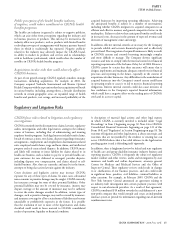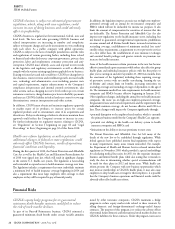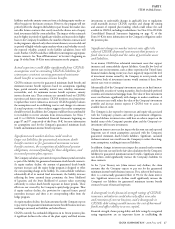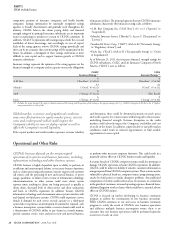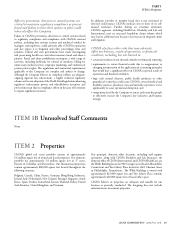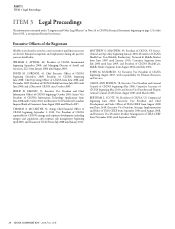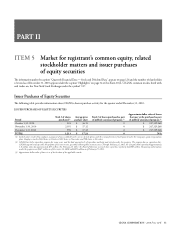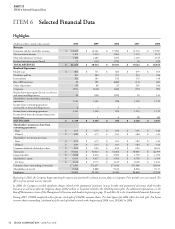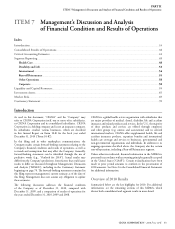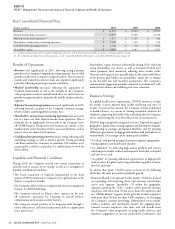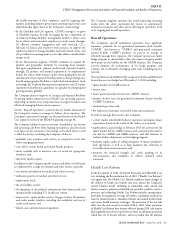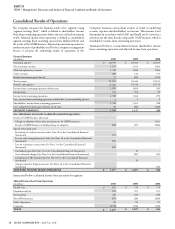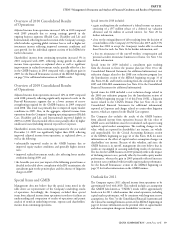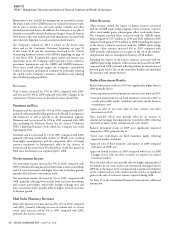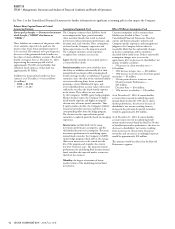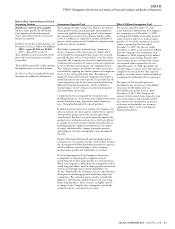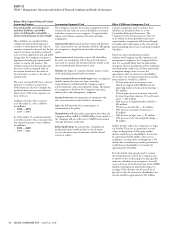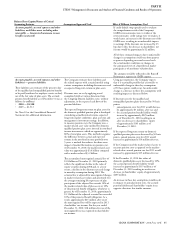Cigna 2010 Annual Report Download - page 55
Download and view the complete annual report
Please find page 55 of the 2010 Cigna annual report below. You can navigate through the pages in the report by either clicking on the pages listed below, or by using the keyword search tool below to find specific information within the annual report.CIGNA CORPORATION 2010 Form 10K 35
PART II
ITEM 7 Management’s Discussion and Analysis of Financial Condition and Results of Operations
the health outcomes of their employees; and (3) targeting sub-
markets including industry, government and municipal entities and
individuals that align closest to the Company’s stated strategy.
•In the Disability and Life segment, CIGNA’s strategy is to grow
its Disability business by fully leveraging the key components of
its industry-leading disability management model to reduce costs
for its clients and return their employees to work sooner through:
(1) eff ective customer engagement and early outreach; (2) a
full suite of clinical and return-to-work resources to support the
employer’s ability to manage disability and work related events; and
(3) specialized case management services that address an individual’s
unique needs.
•In the International segment, CIGNA continues to expand the
product and geographic footprint by executing local strategies
that grow supplemental, primary medical and expatriate benefi ts
through: (1) product and channel expansion in its supplemental
health, life and accident business in key Asian geographies; (2) the
introduction of new expatriate benefi ts products, that provide greater
benefi t and geographic fl exibility to individual and employers (such
as through the Vanbreda International acquisition); and (3) further
expansion of distribution capabilities to capitalize on emerging and
growing markets globally.
e Company plans to improve its strategic and fi nancial fl exibility
by driving further reductions in its Health Care operating expenses,
improving its medical cost competitiveness in targeted markets and
eff ectively managing balance sheet exposures.
See the “Run-off operations” section below for further discussion of
the Company’s actions to manage its balance sheet exposures. e
Company’s operational strategies are discussed further in the Health
Care segment section of the MD&A beginning on page 48.
e Company’s ability to increase revenue, shareholders’ net income
and operating cash fl ows from ongoing operations is directly related
to progress on the execution of its strategy as described above as well
as other key factors, including the Company’s ability to:
•profi tably price products and services at competitive levels that
refl ect emerging experience;
•cross sell its various health and related benefi t products;
•invest available cash at attractive rates of return for appropriate
durations; and
•eff ectively deploy capital.
In addition to the Company-specifi c factors cited above, overall results
are infl uenced by a range of economic and other factors, especially:
•cost trends and infl ation for medical and related services;
•utilization patterns of medical and other services;
•employment levels;
•the tort liability system;
•developments in the political environment both domestically and
internationally, including U.S. health care reform;
•interest rates, equity market returns, foreign currency fl uctuations
and credit market volatility, including the availability and cost of
credit in the future; and
•federal, state and international regulation.
e Company regularly monitors the trends impacting operating
results from the above mentioned key factors to appropriately
respond to economic and other factors aff ecting its operations, both
in its ongoing and run-off operations.
Run-off Operations
e Company’s run-off reinsurance operations have signifi cant
exposures, primarily for its guaranteed minimum death benefi ts
(“GMDB”, also known as “VADBe”) and guaranteed minimum
income benefi ts (“GMIB”) products. As part of its strategy to
eff ectively manage these exposures, the Company operates an equity
hedge program to substantially reduce the impact of equity market
movements on the liability for the GMDB business. e Company
actively monitors the performance of the hedge program, and
evaluates the cost/benefi t of hedging other risks, including interest
rate risk.
ese products are also infl uenced by a range of economic and behavioral
factors that were not hedged as of December 31, 2010, including:
•equity markets for GMIB contracts;
•interest rates;
•future partial surrender elections for GMDB contracts;
•annuity election rates for guaranteed minimum income benefi ts
(“GMIB”) contracts;
•annuitant lapse rates; and
•the collection of amounts recoverable from retrocessionaires.
In order to manage these factors, the Company:
•actively studies policyholder behavior experience and adjusts future
expectations based on the results of the studies, as warranted;
•implemented a partial hedge in February 2011 for a portion of the
equity market risk for GMIB contracts and a portion of the interest
rate risk for GMDB and GMIB contracts, and will continue to
evaluate further adjustments to the hedging program;
•performs regular audits of ceding companies to ensure compliance
with agreements as well as to help maximize the collection of
receivables from retrocessionaires; and
•monitors the fi nancial strength and credit standing of its
retrocessionaires and establishes or collects collateral when
warranted.
Health Care Reform
In the fi rst quarter of 2010, the Patient Protection and Aff ordable Care
Act, including the Reconciliation Act of 2010, (“Health Care Reform”)
was signed into law. Health Care Reform mandates broad changes in
the delivery of health care benefi ts that may impact the Company’s
current business model, including its relationship with current and
future customers, producers and health care providers, products, services,
processes and technology. Health Care Reform includes, among others,
provisions for mandatory coverage of benefi ts, a minimum medical loss
ratio for insured business, eliminates lifetime and annual benefi t limits
and creates health insurance exchanges. e provisions of the law take
eff ect over the next several years from 2010 to 2018. Many provisions
of Health Care Reform have become eff ective during 2010, and interim
fi nal regulations have been issued, however there are still many provisions
which have yet to become eff ective, and it is possible that the ultimate


